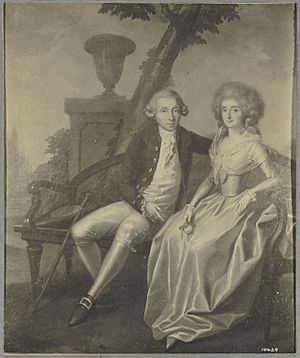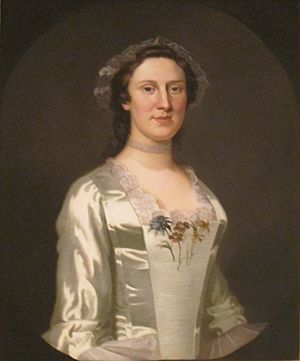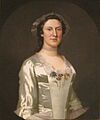Theodosia Bartow Prevost facts for kids
Quick facts for kids
Theodosia Bartow Prevost
|
|
|---|---|

Theodosia Bartow and her husband Aaron Burr, portrait by Henry Benbridge
|
|
| Born |
Theodosia Bartow
November 2, 1746 Shrewsbury Township, New Jersey
|
| Died | May 18, 1794 (aged 47) |
| Resting place | St. John's Burying Ground, New York |
| Other names | Theodosia Bartow Burr |
| Known for | American Revolution Patriot |
| Spouse(s) | |
| Children | 7 or more, including John Bartow Prevost and Theodosia Burr Alston |
| Parent(s) | Ann Sands Stillwell Theodosius Bartow |
Theodosia Bartow Prevost (born November 1746 – died May 18, 1794) was an important American Patriot. She was also known as Theodosia Bartow Burr after her second marriage. Theodosia grew up with her mother. At 17, she married Jacques Marcus Prevost, a British Army officer.
When the American Revolution began, Theodosia supported the American side. She opened her home, the Hermitage, to revolutionaries. Famous leaders like Alexander Hamilton, Marquis de Lafayette, and Aaron Burr visited her home. Even George Washington used her house as his headquarters for a short time. He considered her a friend. Theodosia and Aaron Burr fell in love. After her first husband died, they got married.
The couple moved to New York City. Theodosia was a key helper and friend to Aaron Burr as he started his political career. She was known for being smart and well-educated. Her death in 1794 was a big loss for Burr.
Contents
Theodosia's Early Life
Theodosia was born in November 1746 in Shrewsbury Township, New Jersey. Her father, Theodosius Bartow, was a lawyer. He died a few weeks before she was born. Her mother, Ann Sands Stillwell, raised her alone for five years. Then, Ann married Philip de Visme, a Captain in the British Army.
Theodosia received a very good education. She learned to speak French fluently. She later used her French skills to translate political writings. At age 17, Theodosia married Jacques Marcus Prevost in 1763. He was a Swiss officer in the British Army. They had five children together. When Jacques Prevost went to the West Indies in the 1770s, Theodosia and her children stayed in New Jersey.
Role in the Revolutionary War

Even though her husband and stepfather were British officers, Theodosia supported the American Patriots. Her home, the Hermitage, became a meeting place for American soldiers. It was named after a cottage belonging to a famous French writer, Jean-Jacques Rousseau.
In July 1778, after the Battle of Monmouth, Theodosia invited George Washington to stay at her home. He accepted and used the Hermitage as his headquarters for a short time. Theodosia's home was known for its French style and smart conversations. Other important visitors included generals Charles Lee and Jeremiah Wadsworth.
During the war, there was a risk that Theodosia's property could be taken by the government. This was because her husband was a Loyalist (someone who supported the British). But her powerful friends, like William Livingston, helped to protect her home.
Theodosia met Aaron Burr in August 1778. They became good friends, and Burr started visiting her home often. By 1780, they were a couple, even though Aaron was 10 years younger. In December 1781, Theodosia learned that her husband had died from yellow fever.
Theodosia and Burr wrote many letters to each other. They discussed politics, philosophy, and ideas about women's rights. They talked about writers like Rousseau and the British feminist Mary Wollstonecraft. They wanted their relationship to be based on love and respect, not just social rules. This idea appealed to Theodosia's independent spirit. After Burr became a lawyer, they married on July 2, 1782, at the Hermitage. Their only child who lived to adulthood, also named Theodosia, was born in June 1783.
Later Years and Passing
The Burr family moved to New York City in 1783. As Aaron's law career grew, he traveled more often. But their strong intellectual partnership continued. They wrote honest letters to each other. Theodosia often disagreed with her husband's ideas and pointed out his mistakes. Aaron treated her as an equal, sending her political books and newspapers.
Theodosia was very good at understanding people. She helped Aaron in his political career, especially after he joined the United States Senate in 1791. Both Theodosia and Aaron believed strongly in education. Theodosia educated their daughter as if she were a wealthy boy. Their daughter could read and write at age three. She studied Latin, Greek, and French. By age 10, she had read Decline and Fall of the Roman Empire.
Theodosia's health began to get worse. She had been ill for a long time, but by 1792, she was in constant pain. Aaron offered to leave the Senate to spend more time with her, but she did not let him. She passed away on May 28, 1794, at the age of 47. She was buried in St. John's Burying Ground in New York. Aaron later said she was "the best woman and finest lady" he had ever known.
Images for kids





